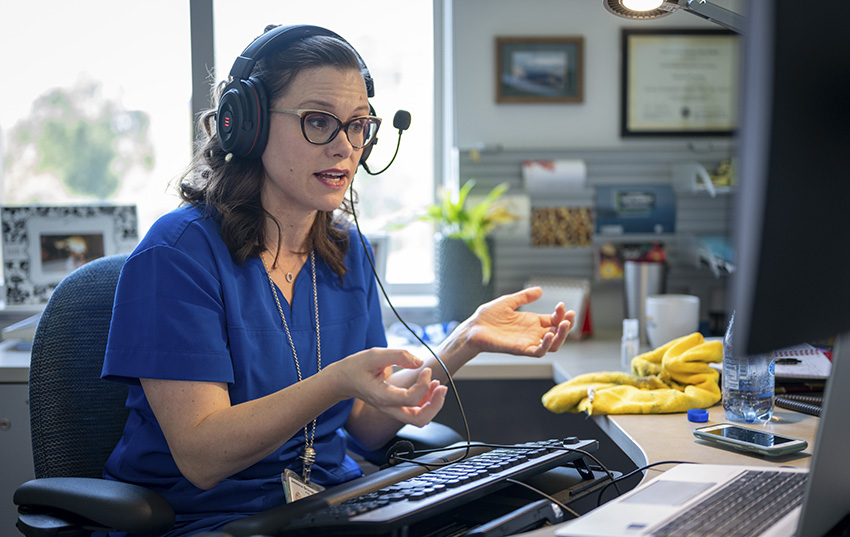Faculty move courses online
Pandemic prompts quick response, lifelong learning

Jessica Draughon Moret, assistant director for the Master’s Entry Program in Nursing, explains that moving courses online is more than a change of delivery. The move also requires faculty to think through
When stay-at-home orders hit California last March, students at the Betty Irene Moore School of Nursing at UC Davis were one week away from winter quarter finals. Shared study spaces, in-class lectures and face-to-face learning were the norm. In an instant, the novel coronavirus pandemic turned that reality turned into logging on from home, virtual classrooms and no in-person interaction.
Faculty pivoted to rework didactic and clinical coursework from in-person experiences to remote instruction. They had to be prepared for spring quarter in 14 days.
“Had I had a month’s notice rather than two weeks, I might have been able to bring more best practices into the picture,” said Jessica Draughon Moret, an assistant clinical professor and assistant director for the Master’s Entry Program in Nursing. “I had enough time to change up the delivery, but I needed more time to think through the students’ different styles of learning and how to make coursework engaging.”
Assistant Clinical Professor Brent Luu likened the transition to driving a sedan smoothly on a freeway and suddenly moving behind the wheel of an 18-wheeler at the same speed.
“There are so many blind spots,” said Luu, a pharmacist who teaches physician assistant and nurse practitioner students. “I can gauge students’ understanding in the classroom through non-verbal clues, such as a blank stare or uneasy posture. Online, I face four pages of thumbnail images to see everyone in class.”
Instead of changing class activities to fit the available technologies, faculty adopted the technologies to fit their class activities. Luu kept his format consistent with his in-person structure, beginning with individual and team readiness assessment tests then lecture.
“Teaching online is not the same as teaching face to face in a classroom,” said Elizabeth Rice, associate dean for student and faculty success. “We developed Canvas modules and workshops for faculty that provided educational best practices, skills in using technology such as Zoom, and a forum for learning about student engagement and inclusivity in a new environment.”
Additionally, faculty recognized that students were stressed and needed additional support to make the learning transition as user-friendly as possible. Faculty added extra Zoom office hours and collaborated across classes to ensure that the workload for students was reasonable.
“The work faculty and staff do to support students’ education can sometimes be invisible when everything goes smoothly,” Rice adds. “But I saw how everyone worked together tirelessly to learn and employ new methods of teaching to support our students.”
Draughon Moret began with two weeks of synchronous engagement followed by three weeks of activities for students to complete on their own schedule.
“I actually figured out a way to present an evolving case completely asynchronously using Canvas,” Draughon Moret says.
Associate Clinical Professor Susan L. Adams tackled an additional challenge: moving online an interprofessional convening of nursing and veterinary medicine students to learn how to assess and manage pain in non-verbal mammals.
“The challenging part was creating the small group breakout rooms, so that the evolving case discussion could still occur. Fortunately, Zoom has a breakout room option and we were able to keep this part of the experience,” Adams says.
“I learned the importance of being patient and consistent,” Luu adds. “Consistency decreased the level of anxiety and confusion significantly after a few Zoom sessions.”
Anxiety that was felt by students and faculty alike in a time when everyone was forced into the role of learner.
“I have a toddler. I have three full time jobs — mother, educator and home engineer — that I can’t get away from,” Draughon Moret says. “But many of my students are also juggling family obligations that are 24/7 when public health and safety are at stake.”
In the long run, faculty learned how to adapt and students learned to prioritize workload, not overthink assignments and reach out through virtual office hours to stay on track.
“The skills of prioritization and time management are transferable to nursing. Having to make decisions when everyone feels yucky transfers to their future careers,” Draughon Moret adds. “It may not be best to tell them that now, but they’ll learn the consequences to decisions that are being made and be better nurses for it.”
Read this and other stories in the 2020 Betty Irene Moore School of Nursing Magazine





